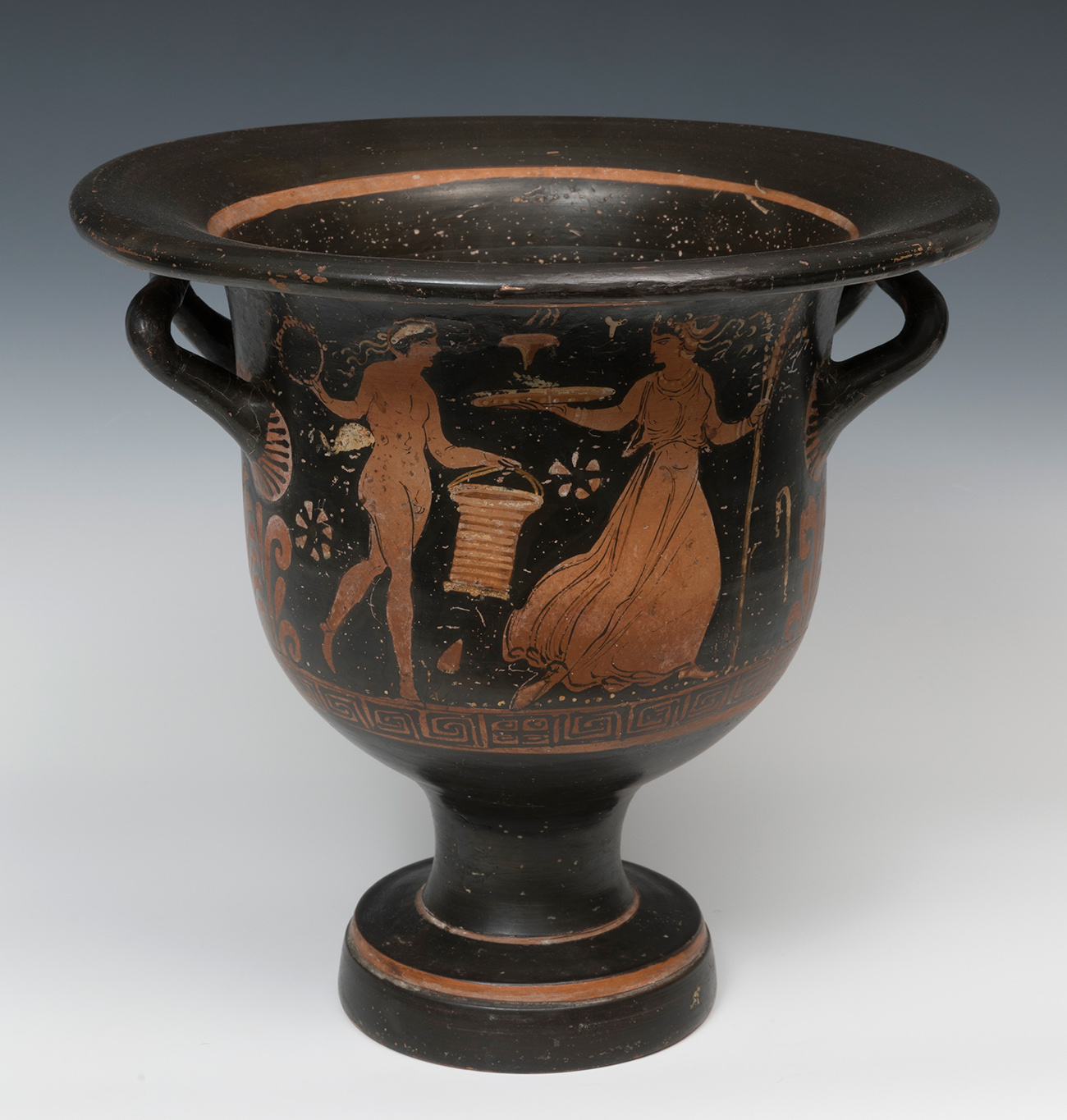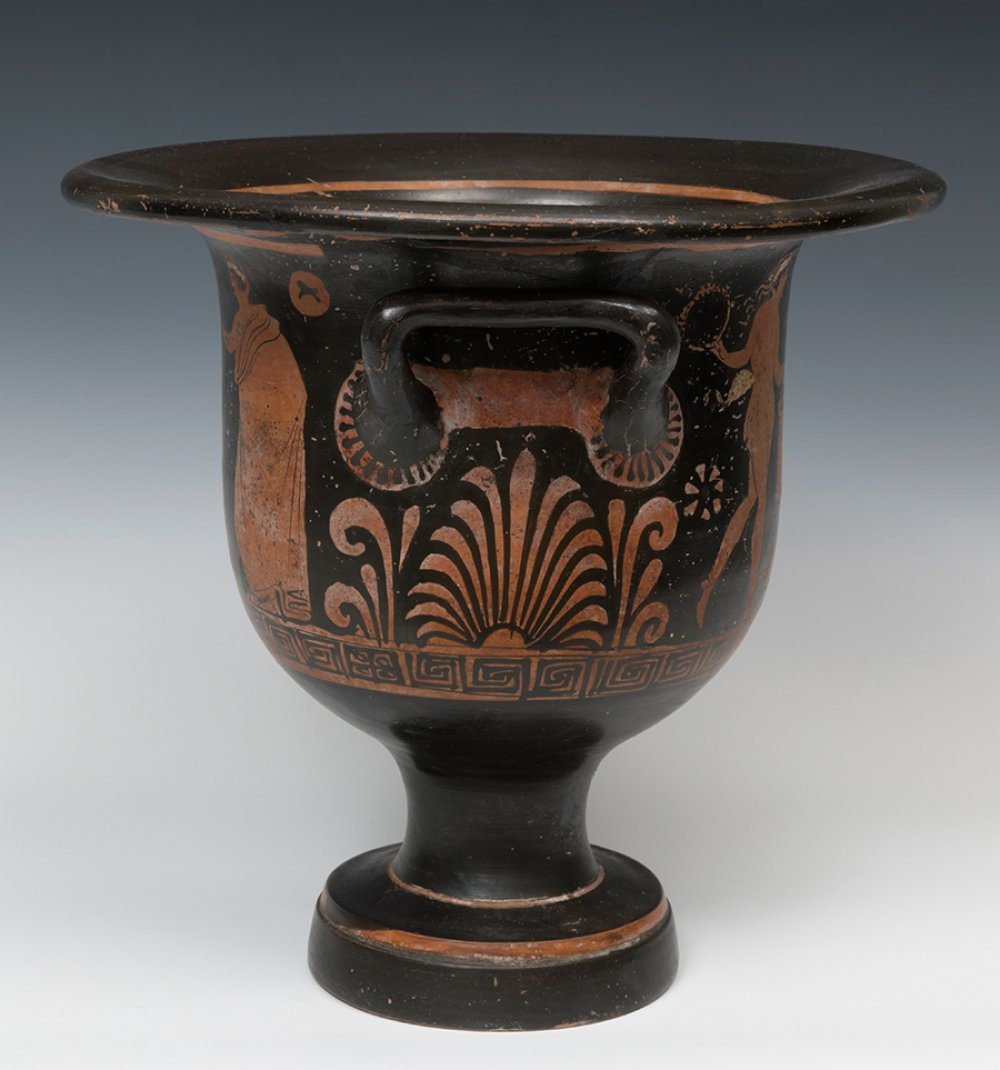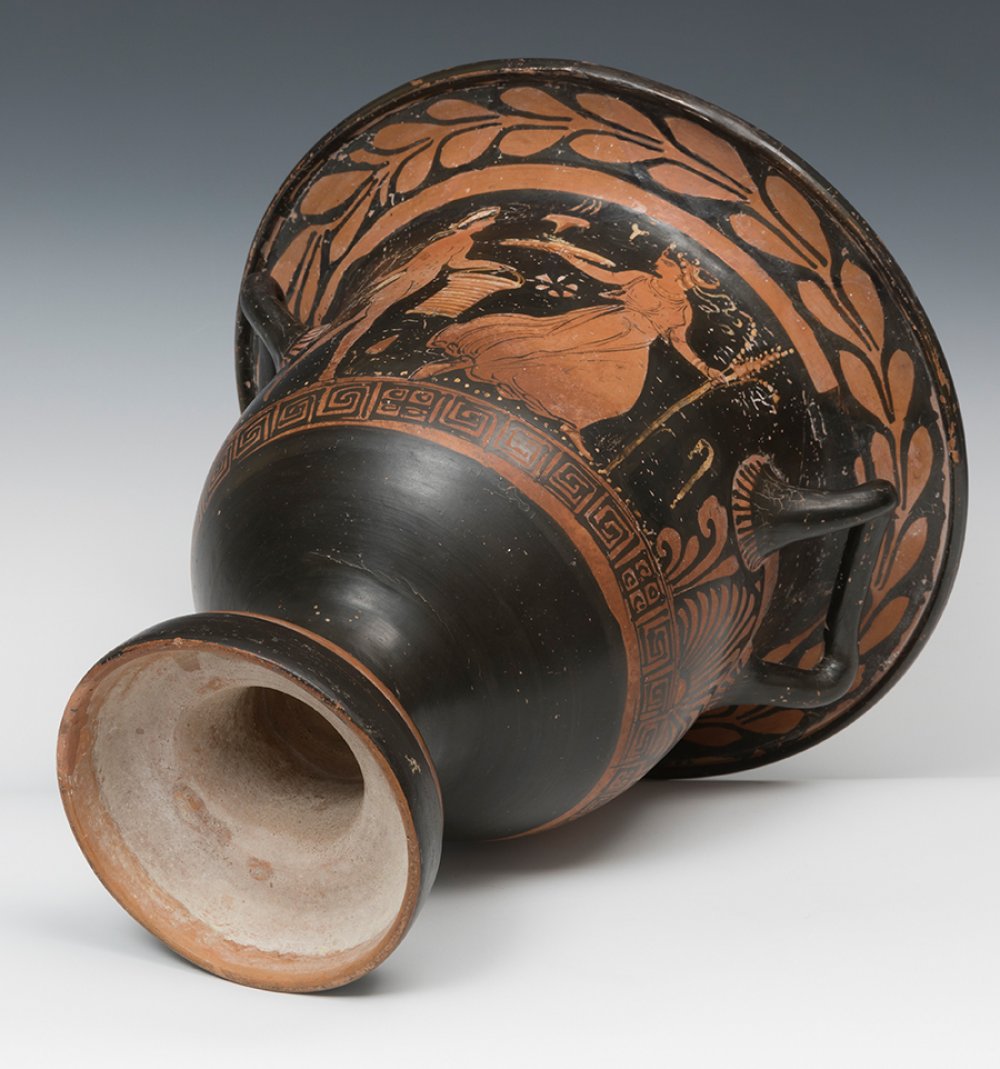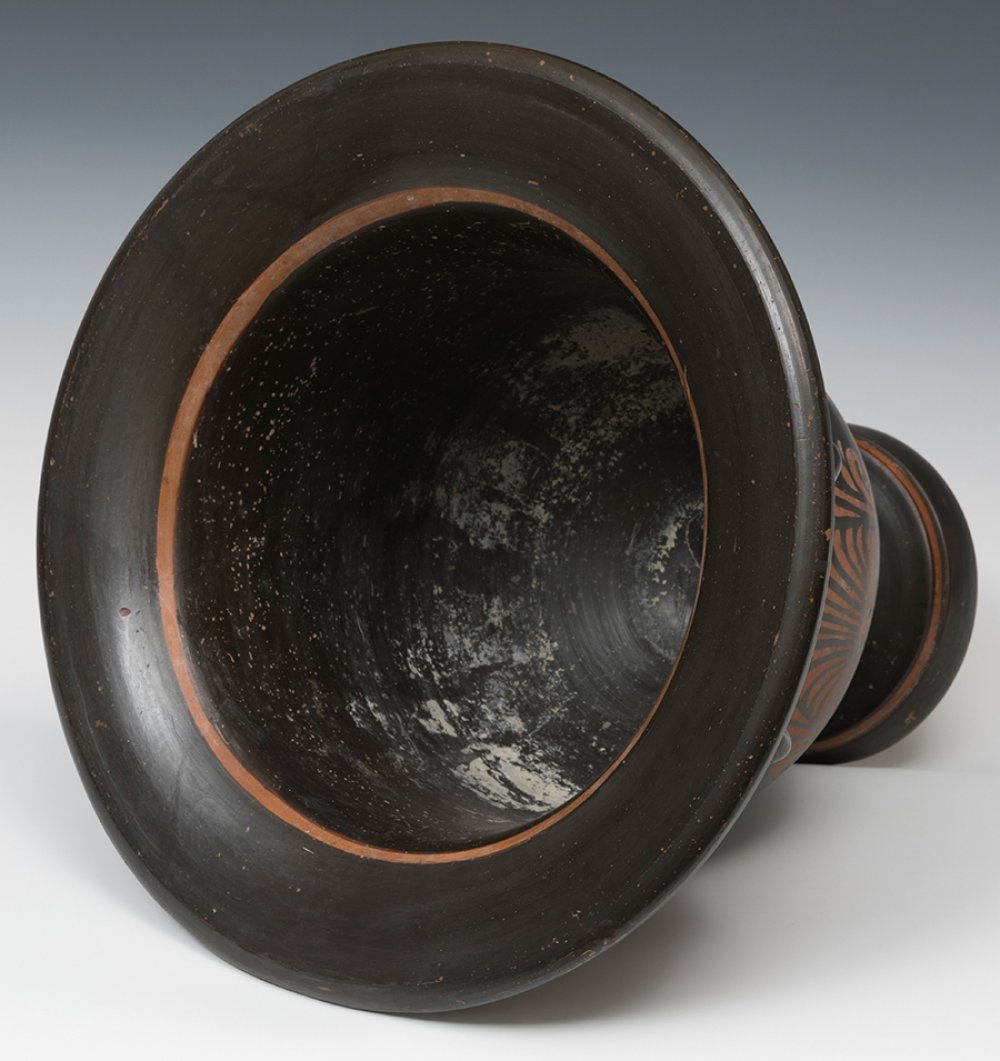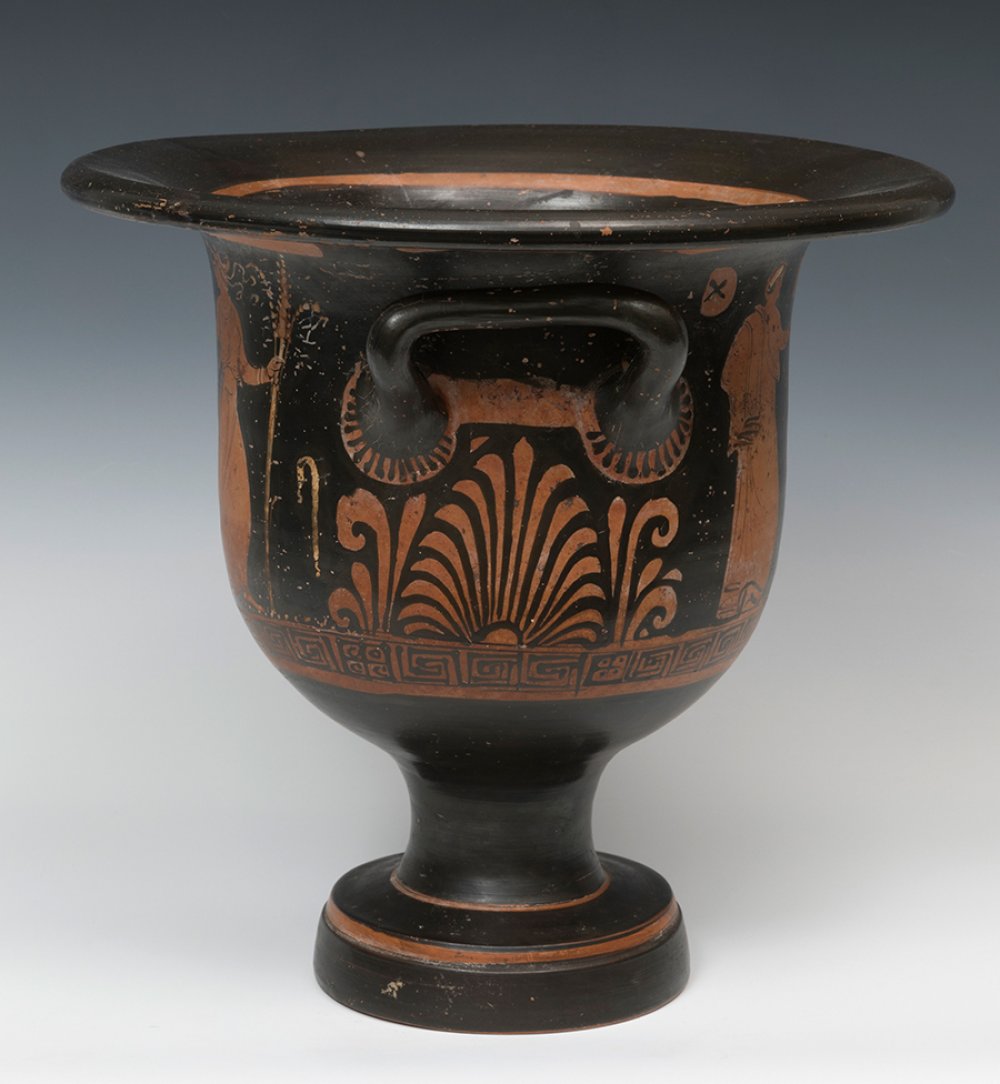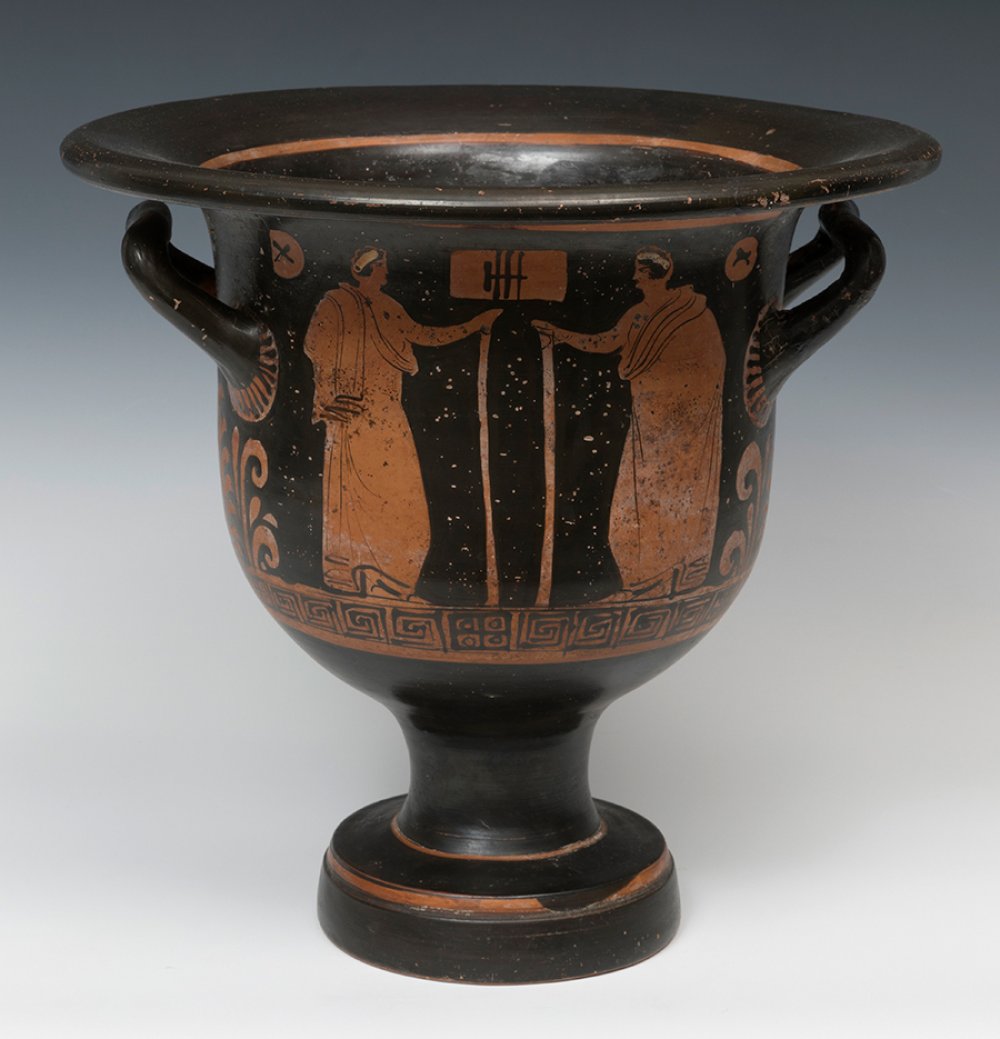16
Campana cratera; Apulia, Magna Graecia, 4th century BC.Red-figured pottery.Thermoluminescence
Red-figured pottery.
Thermoluminescence attached.
It has restorations on fracture lines and a later addition in the lip area.
Provenance: French Private Collection.
Measurements: 25 x 24 cm (diameter).
Ceramic vessel with a circular base, bell-shaped body with two handles, which are almost hidden under a pronounced rim at the top, which also opens outwards. The exterior of the piece is decorated on the obverse with the figures of a nude satyr, with situla and laurel wreath, and a maenad with fiale and thyrsus. On the reverse, the scene is depicted with two figures holding staffs. The crater was a large vessel intended to contain a mixture of water and wine. It was carried to the place where the meal was to be served and placed on the floor or on a platform. The cupbearer administered the drink with a spoon or jug, and then filled the cups of the guests. The type known as 'bell-shaped' has small horizontal, protruding, upward-facing handles and an inverted bell-shaped vessel; it is a late-use type. The chalice krater is a more modern type than the column and scroll kraters, although it predates the bell krater, and its shape, with an almost inverted trapezoid profile, is reminiscent of the flower chalice.
Red-figure ware was one of the most important figurative styles of Greek pottery. It was developed in Athens around 530 BC, and was used until the 3rd century BC. It replaced the previous predominant style of black-figure ware within a few decades. The technical basis was the same in both cases, but in the red figures the colouring is inverted, with the figures highlighted against a dark background, as if illuminated by a theatrical light, following a more natural scheme. Painters working with black figures were forced to keep the motifs well separated from each other and to limit the complexity of the illustration. The red-figure technique, on the other hand, allowed greater freedom. Each figure was silhouetted against a black background, allowing the painters to portray anatomical details with greater accuracy and variety.
The technique consisted of painting the motifs on the still-wet piece, using a transparent varnish which, when fired, took on an intense black hue. The motifs were therefore invisible before firing, which meant that the painters had to work entirely from memory, unable to see their previous work. Once the piece was fired, the unglazed areas remained with the reddish hue of the clay, while the glazed, "painted" areas took on a dense, glossy black colour.
Red-figured pottery.
Thermoluminescence attached.
It has restorations on fracture lines and a later addition in the lip area.
Provenance: French Private Collection.
Measurements: 25 x 24 cm (diameter).
Ceramic vessel with a circular base, bell-shaped body with two handles, which are almost hidden under a pronounced rim at the top, which also opens outwards. The exterior of the piece is decorated on the obverse with the figures of a nude satyr, with situla and laurel wreath, and a maenad with fiale and thyrsus. On the reverse, the scene is depicted with two figures holding staffs. The crater was a large vessel intended to contain a mixture of water and wine. It was carried to the place where the meal was to be served and placed on the floor or on a platform. The cupbearer administered the drink with a spoon or jug, and then filled the cups of the guests. The type known as 'bell-shaped' has small horizontal, protruding, upward-facing handles and an inverted bell-shaped vessel; it is a late-use type. The chalice krater is a more modern type than the column and scroll kraters, although it predates the bell krater, and its shape, with an almost inverted trapezoid profile, is reminiscent of the flower chalice.
Red-figure ware was one of the most important figurative styles of Greek pottery. It was developed in Athens around 530 BC, and was used until the 3rd century BC. It replaced the previous predominant style of black-figure ware within a few decades. The technical basis was the same in both cases, but in the red figures the colouring is inverted, with the figures highlighted against a dark background, as if illuminated by a theatrical light, following a more natural scheme. Painters working with black figures were forced to keep the motifs well separated from each other and to limit the complexity of the illustration. The red-figure technique, on the other hand, allowed greater freedom. Each figure was silhouetted against a black background, allowing the painters to portray anatomical details with greater accuracy and variety.
The technique consisted of painting the motifs on the still-wet piece, using a transparent varnish which, when fired, took on an intense black hue. The motifs were therefore invisible before firing, which meant that the painters had to work entirely from memory, unable to see their previous work. Once the piece was fired, the unglazed areas remained with the reddish hue of the clay, while the glazed, "painted" areas took on a dense, glossy black colour.
10th November - Ancient Art
Sale Date(s)
Venue Address
General delivery information available from the auctioneer
Setdart offers Worldwide shipping
PICK UP IN ROOM: You can come and pick up your lots in our offices (Barcelona, Madrid or Valencia). At the moment of the withdrawal, you will be able to accept the current conditions of the lot by means of a document that you will sign.
YOU CAN SEND ANOTHER PERSON TO PICK UP: This person must present a signed authorization that you can find in our web page by accessing from BUY AT SETDART- LOGISTICS-DOWNLOAD AUTHORIZATION DOCUMENT. You can also send an e-mail with the requested data in AUTHORIZATION DOCUMENT to admin@setdart.com
Important Information
25% buyer´s premium
Terms & Conditions
The maximum period to pay the lots is 7 working days. You can pay either via bank transfer or with credit card through our platform www.setdart.com (we only accept VISA or Mastercard).
BUYER´S PREMIUM: 22% Hammer price + 21% VAT from the buyer´s premium
If your piece has more than 100 years, our Ministry of Culture requires an export certificate in order for the piece to leave the country. Note that if the piece goes inside the EU, there is no cost for the export certificate. If the piece goes outside the EU, there is a cost for the export certificate. You can find more information in our Ministry of Culture website: https://www.culturaydeporte.gob.es/en/cultura/patrimonio/exportacionimportacion/exportacion/tasas.html
INQUIRIES: admin@setdart.com
Setdart guides you through the entire process, from the time of award to the day you receive your lot. Our logistics team will be happy to manage your transport, and will advise you on the best shipping method with professionals from the sector used to handling works of art and jewelry.
WE OFFER WORLDWIDE DOOR TO DOOR SHIPPING
PICK UP IN ROOM: You can come and pick up your lots in our offices. At the moment of the withdrawal, you will be able to accept the current conditions of the lot by means of a document that you will sign.
YOU CAN SEND ANOTHER PERSON TO PICK UP: This person must present a signed authorization that you can find in our web page by accessing from BUY AT SETDART-LOGISTICS-DOWNLOAD AUTHORIZATION DOCUMENT. You can also send an e-mail with the requested data in AUTHORIZATION DOCUMENT to admin@setdart.com
SETDART IS NOT RESPONSIBLE FOR THE STATE OF THE PARTS ONCE THEY LEAVE OUR FACILITIES. MRW SHIPMENTS: Once the payment is made, your lot will be packed for shipment, the logistics department will send you an e-mail notifying you of the day it leaves our warehouse, changes of address cannot be made after receiving this e-mail.
INSURANCE INCIDENTS: Coverage for the value of the auction up to 3000 ? per shipment, if the value of the auction is higher, Setdart will send you a quote including the additional insurance. The insurance company WILL NOT BE RESPONSIBLE FOR THE SHIPMENT THAT EXCEEDS THAT AMOUNT AND IS NOT FULLY INSURED. MRW INCIDENTS: Maximum notification 48 hours after receipt, after which the insurance company WILL NOT BE RESPONSIBLE AND NO CLAIMS WILL BE ACCEPTED.
E-MAIL LOGISTICS: logistica@setdart.com
PICK UP YOUR MESSAGES: You can send your own messaging, prior notice via e-mail that your shipment is ready, please note 3 or 4 days in advance. This type of shipment is packaged so Setdart will provide you with a quote.
EXPENSES FOR STORAGE: We inform you that if the purchased lot is not picked up within a month, you will be charged 30€ per week per lot. Setdart Online S.L., owner of the web site "setdart.com", "setdart.net" and "setdart.org", acts as a company of Spanish nationality inscribed in the Volume 36955, sheet 182, page B-293056 of the Mercantile Registry, with registered office at Calle Aragó













